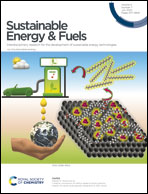Efficient defect passivation of perovskite solar cells via stitching of an organic bidentate molecule†
Abstract
The defects present in solution-processed perovskite light absorbing materials are responsible for deteriorating the performance and stability of perovskite solar cells. Therefore, suppressing the defect formation and passivating the pre-existing defects in perovskite materials are of paramount importance in pushing the efficiency of perovskite solar cells (PSCs) toward the theoretical limit and ensuring the long-term stability of PSCs. In this work, we report an efficient defect passivation route using a bidentate small organic molecule, pyrazine, which is capable of making either a monodentate or a bridging bidentate bond with under-coordinated Pb2+ ions mainly present in the surface and grain boundaries of perovskite films. The various analyses for the defect density and charge carrier lifetime of perovskite light absorbing layers demonstrated that pyrazine effectively passivated defects existing on the surface and grain boundaries of the perovskite films without affecting the morphology and crystallinity via a simple post-treatment procedure. As a result, the best untreated device obtained a power conversion efficiency of 19.14%, while an efficiency of 20.58% was achieved when pyrazine treated.

- This article is part of the themed collection: Sustainable Energy & Fuels Cover Art


 Please wait while we load your content...
Please wait while we load your content...